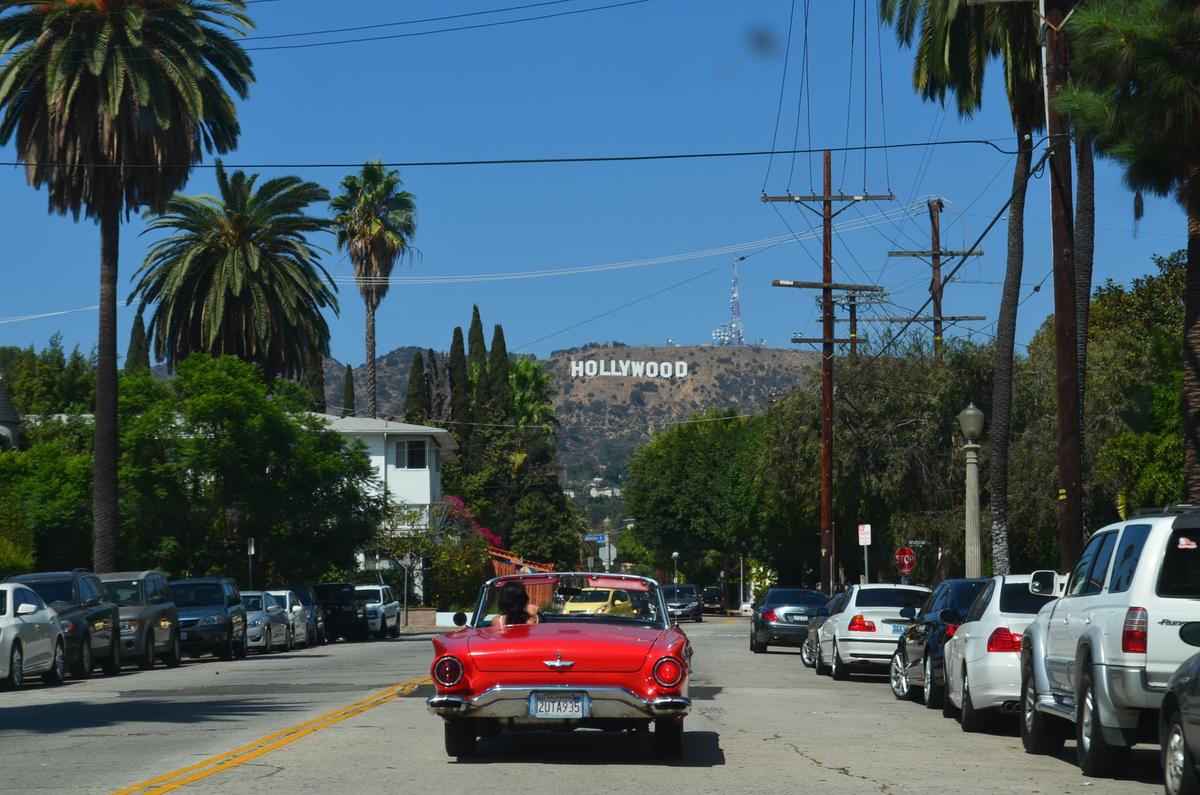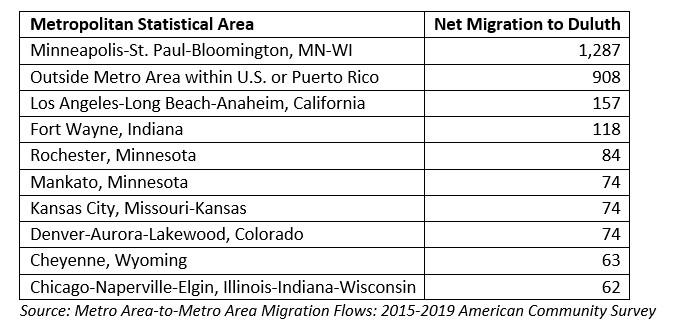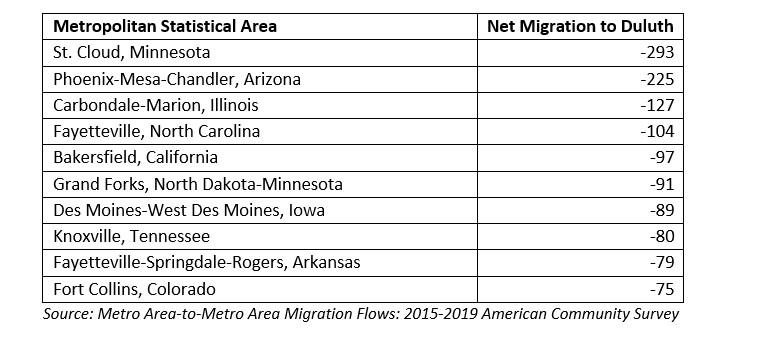While climate migration may seem like a future scenario, many of the people interviewed for our study on the topic of climate migration mentioned that they themselves had considered climate change as part of their decision to relocate to Duluth or that they have acquaintances who moved here away from severe conditions causing extreme wildfires or severe droughts. While anecdotal, this suggests that climate migration to Duluth may already be happening at some level.
For this week’s blog, we decided to examine recent trends in migration to and from the Duluth-Superior metropolitan statistical area (hereafter referred to as the Duluth MSA) to better understand how many people have migrated to the region in recent years (and from where), how many residents of the Duluth MSA have migrated elsewhere, and what that means for the future of our region.
According to the U.S. Census Bureau, population growth has been relatively flat in Duluth and the surrounding region since 2010. St. Louis County added just five new residents over the past decade. The city of Duluth added more, at 432, but that still represented less than 1% growth for the city. The Duluth MSA, which includes Carlton, St. Louis, and Lake Counties in Minnesota, and Douglas County, Wisconsin, added just over 1,000 residents, an increase of 0.3% from 2010.
However, while the region’s population has not seen dramatic increases in the past decade, the Duluth MSA saw net positive migration in just five years (2015 to 2019) according to data from the American Community Survey’s Metro-to-Metro Migration Flows dataset. The Census Bureau estimates that 1,774 more residents moved to the Duluth MSA than moved away from the area during the five-year period.
Table 1 shows the ten cities with the highest positive net migration to the Duluth MSA. More people moved to Duluth from these areas than vice versa. For example, between 2015 and 2019, an estimated 5,417 residents moved from the Minneapolis-St. Paul metro area to the Duluth MSA, while 4,130 residents moved in the other direction, leading to a positive net migration of 1,287 to the Duluth MSA from the Twin Cities.
Other metro areas with positive net migration to Duluth include Los Angeles; Fort Wayne, Indiana; Rochester, Minnesota; Mankato, Minnesota; Kansas City, Missouri-Kansas, and Denver, Colorado.
With the exception of Los Angeles or possibly Denver, none of the metro areas from which the Duluth MSA has gained residents appear to be regions that are experiencing extreme impacts from climate change. Instead, most of the metro areas from which Duluth has gained residents are other communities in Minnesota and the Midwest. Notably, the second largest area from which the Duluth MSA has seen population increases is “Outside Metro Area within U.S. or Puerto Rico,” which simply refers to rural or non-metro counties in the U.S.
Table 1. Metro Areas with Highest Net Migration to Duluth-Superior
Table 2 shows the ten cities with the lowest levels of net migration to Duluth-Superior. Between 2015 and 2019, the Duluth MSA lost the largest number of residents to St. Cloud, Minnesota; Phoenix, Arizona; Carbondale, Illinois; Fayetteville, North Carolina; and Bakersfield California.
Table 2. Metro Areas with Lowest Net Migration to Duluth-Superior
While we don’t have demographic information on the movers shown in the tables, it is notable that Phoenix and Knoxville are both communities with mild climates and large populations of residents over 65 years of age, suggesting that those cities may be attracting retirees from Duluth in search of warmer weather. In Phoenix, 15.3% of the population was over 65 years of age, and in Knoxville 17.9% of the population was over 65. Notably, the 65+ population in the Duluth MSA was higher than either community, at 18.7%.
Clearly, migration to the Duluth MSA is not yet overwhelming the region with new residents. Over the past five years, the Census Bureau estimates that migration to the region added fewer than 2,000 new residents, which has helped the region’s population remain stable and has not led to significant growth. The region has seen the greatest numbers of new residents from Minneapolis-St. Paul, followed by non-metro counties in the U.S. However, a small but significant number of new residents that migrated to the Duluth MSA from 2015 to 2019 came from Los Angeles, which could represent a population that is moving to escape the impacts of drought or wildfire. The BBER will continue to monitor these trends in the coming years to better understand how migration to and from other communities is impacting our population and demographics.
Photo by Daniel Semenov from Pexels


